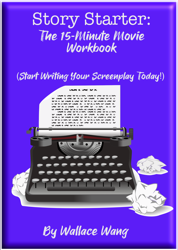Narration occurs when a character or unseen person tells the audience important information to help them understand the story. Narration typically appears in the beginning of a story because if it appeared in the middle of the story, the narration would interrupt the flow of the story.
Narration typically condenses lots of information in a short amount of time. The purpose is to give us just enough information to understand the story. In “Beauty and the Beast,” an unseen narrator explains how there once lived a prince who was cruel and unkind. One day a beggar showed up at his door and offered him a rose in exchange for shelter from the cold. When the prince refused, the beggar revealed herself to be an enchantress who puts a spell on the prince to become a hideous beast. Only if he can learn to love before the petals on the rose fall away can he break the spell. Otherwise he’ll be condemned to appear as a beast forever.
Narration in the beginning can also set the tone of the story while giving us crucial information to understand the rest of the story. In “Barbie,” an unseen narrator describes how girls used to play with dolls that looked like babies. Then Barbie appeared and girls could now play with a doll that represented what a woman could become.
Narration is especially important in fantasy, science fiction, or historical stories because audiences won’t be familiar with the story setting or background. The key to narration is to tell a mini-story that begins with a problem and ends with a conclusion that leads into the actual story itself. By telling a mini-story, narration keeps our attention while entertaining us as well instead of simply reciting dry facts that lack any emotional meaning.
In “Beauty and the Beast,” the narration helps us understand who the beast is and what needs to be done to turn him back into a human. In “Barbie,” the narration helps us understand the impact of Barbie on giving girls the right to be anything they want to be, which sets up the story of Barbie living in Barbieland. Without this crucial narration in the beginning, neither story would make much sense.
Similar to narration is text, most famously seen in the opening of “Star Wars” where large amounts of text help us understand what’s going on. Text often lacks the mini-story that narration provides, so text should be shorter. To grab our attention, the text should highlight a problem or conflict so that way it also feels important. Without conflict or a problem, text risks just dumping information on us.
In “Napoleon,” text explains how the French have become disillusioned by food shortages and economic depression. This helps us understand the background for the rest of the story, but notice that food shortages and economic depression emphasize conflict and dissatisfaction. This same information could be given without any hint of conflict such as stating that food availability is 40% less than the previous year and the economy growth is -5.8%. Such dry facts tell the same story but lack any hint of a problem, which is necessary to make facts told through text interesting.
While narration usually appears in the beginning (and nowhere else in the story), “Terminator 2” offers narration at the very end of the story. In the end of “Terminator 2,” Sarah Connor explains that she’s heading into an unknown future with a sense of hope because if a machine can learn the value of human life, then maybe we can too.
Narration is not a common technique in most movies, but if your story demands extra background information, then consider using narration. As an alternative to narration, simply drop us into the story and give us enough clues to figure out what’s going on anyway.
“The Hunger Games” takes place in a future America, but rather than burden us with narration to explain everything, the movie keeps giving hints of the story throughout the beginning until we learn what’s going on. Sometimes narration can be a quick way to give information to an audience and sometimes it may be better to let audiences figure out what’s going on through the action of the story like “The Hunger Games.”
Narration is simply one more tool to consider so try it if your story needs it and see if your story works better with or without narration.
Sign up to take a FREE course about how to write scenes in a screenplay.

